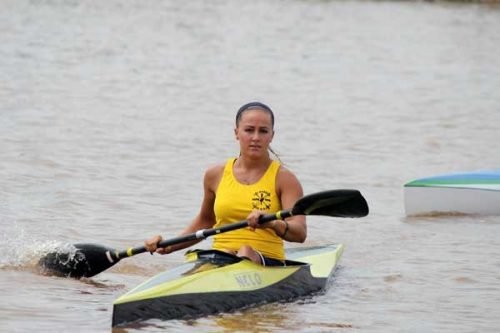 Megan Blunk, of Lakebay, plies the waters during USACK Nationals in Oklahoma City in August. The former Peninsula High School student recently won two silver medals at Paracanoe World Championships in Dusiburg, Germany. Photo courtesy Megan Blunk
Megan Blunk, of Lakebay, plies the waters during USACK Nationals in Oklahoma City in August. The former Peninsula High School student recently won two silver medals at Paracanoe World Championships in Dusiburg, Germany. Photo courtesy Megan Blunk
Lakebay’s Megan Blunk has the heart of a champion and the arms to prove it.
She won two silver medals during her first Paracanoe World Championships in Duisburg, Germany, on Aug. 28, and she has set her sights higher.
“It makes me just want to fight that much harder and win next time,” she said.
Blunk competed in the Trunk and Arms (TA) classification. She came in second place in the women's K-1 and V-1 races. Her K-1 final finish time was 57.507, just half a second behind first place, Emma Wiggs of Great Britain. Improving on her K-1 heat, Blunk turned in a time of 1:10.838 in the V-1 final, 7.595 seconds behind Jeanette Chippington of Great Britain.
Alan Anderson, coach of the Gig Harbor Canoe and Kayak racing team, met Blunk about two years ago and was inspired by her drive.
“When I made the decision to add paracanoe to our program, it was my intention to help athletes with disabilities understand our sport and to perhaps give them something healthy and positive to do. I have realized that, working with Megan, it’s kind of the other way around –– she inspires all around her, including me, to be better,” Anderson said.
Blunk said she tries to put herself into uncomfortable situations so she can push herself.
She said it helps her to build confidence and make her stronger.
“When I was able-bodied, I wasn’t happy, but I slacked off and didn’t do anything to change it. Fighting to overcome disability has allowed me to feel like an athlete, and to know who I am.
“It feels really good because it shows me not to second-guess myself and if you just go as hard as you can, then you can accomplish your goals,” Blunk said.
Blunk’s teammate, Ann Yoshida, won the bronze medal in the women's V-1 Arms (A) direct final in 1:31.382, finished 25.754 seconds behind Chippington, the first-place finisher. Yoshida lives in Hillsboro, Ore. Vadim Kin, from Seattle, came in seventh during the V-1 A final.
Ryan Padilla, of Gig Harbor, completed in the men's K-1 A using aluminum braces to support his legs and straps to hold them still. The steering mechanism on his canoe allows him to adjust the rudder to counter side winds. Such modified equipment is typical of Class A paracanoeists, Anderson said.
The Nelo Viper 55 is the standard paracanoe and is designed according to International Canoe Federation Touring Specifications.
According to Nelo, paracanoes are designed for stability and balance and weigh more than other canoes. Paddlers who can use only their arms could be vulnerable to the wind, so their boats have a lower the center of gravity and are heavier on the bottom.
All Paralympic Games are governed by the International Paralympic Committee (IPC). The Paralympics were started in 1948 as a small group of British World War II veterans and has become one of the largest international sporting events today. Paralympians strive for equal treatment with non disabled Olympic athletes, despite a large funding gap between the two events.
Blunk has returned to her study of psychology at University of Illinois at Urbana-Champaign, where she plays wheelchair basketball.
During the next two years, she will train for both basketball and paracanoe and try to qualify for the Paralympic summer games in 2016, in Rio de Janeiro, Brazil, where paracanoe will make its Olympic debut.
The U.S. paracanoe squad currently consists of nine paddlers, and “I am excited to be part of a pioneering effort,” Anderson said.
UNDERWRITTEN BY THE FUND FOR NONPROFIT NEWS (NEWSMATCH) AT THE MIAMI FOUNDATION, THE ANGEL GUILD, ADVERTISERS, DONORS AND PEOPLE WHO SUPPORT INDEPENDENT, NONPROFIT LOCAL NEWS